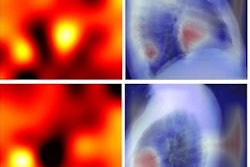
An artificial intelligence (AI) model that analyzed data from blood tests and chest x-rays can identify patients with COVID-19 infections and could serve in some settings as a substitute for reverse transcription polymerase chain reaction (RT-PCR) tests, according to a study published July 9 in Scientific Reports.
Chinese researchers in Hong Kong designed a machine-learning model using blood tests taken during the first and second wave of infection since the start of the COVID-19 outbreak in April 2020. They found when combined with a radiologist's interpretation of x-rays, the model achieved a very high sensitivity in detecting COVID-19 infections.
"Adjunctive use of chest radiograph could play a role in increasing sensitivity while achieving moderate specificity when combined with a [machine-learning] blood model, which may have potential implications in triaging patients, particularly when RT-PCR testing resources are scarce," wrote first author Dr. Richard Du and colleagues at the University of Hong Kong.
Triaging and prioritizing patients suspected of SARS-CoV-2 infection for RT-PCR testing has been essential in the management of the COVID-19 pandemic in resource-scarce countries. While RT-PCR tests are regarded as the gold standard, false-negative rates between 10%-61% have been reported, the authors wrote.
Moreover, there is a disparity in testing capability globally. In Western countries, the cumulative number of tests per population is 10 times that of Asia and 34 times that of Africa, as of the end of August 2020, according to the authors. They propose that substitute tests in resource-scarce settings may be needed to prioritize RT-PCR for vulnerable or high-risk groups.
In this study, Du and colleagues sought to design a machine-learning model for identifying patients suspected of SARS-CoV-2 infection using basic laboratory markers and explored its accuracy when combined with findings on chest x-ray.
After exclusions, the researchers identified a total of 5,148 patients from 24 hospitals in Hong Kong who had taken the RT-PCR test for the SARS-CoV-2 virus from the start of the local outbreak in April 2020. They trained the model to detect SARS-CoV-2 infection using basic laboratory markers, including white cell count, lymphocytes, platelets, C-reactive protein, and lactate dehydrogenase. The investigators then explored results based on the addition of findings on chest x-rays.
For predicting SARS-CoV-2 infection on blood tests, the model achieved high area under the curve (AUC) and specificity (89.9% and 91.5%, respectively), but low sensitivity (57.5%). However, when radiologists' interpretations of chest radiographs were added to the model, it maintained high specificity and achieved a sensitivity over 90%.
 If the Shapley additive explanations (SHAP) output value was above 0.48, then the blood test prediction was positive. The relative contribution of each laboratory marker is shown in the individual SHAP value plot. (a) An elderly female with a positive prediction from chest x-ray (bilateral lower zones shadowing) and positive prediction from laboratory markers. The ground-truth COVID-19 RT-PCR result was positive.
If the Shapley additive explanations (SHAP) output value was above 0.48, then the blood test prediction was positive. The relative contribution of each laboratory marker is shown in the individual SHAP value plot. (a) An elderly female with a positive prediction from chest x-ray (bilateral lower zones shadowing) and positive prediction from laboratory markers. The ground-truth COVID-19 RT-PCR result was positive."Our study showed that a machine-learning model based on readily available laboratory markers could achieve high accuracy in predicting SARS-CoV-2 infection. ... When used together, the combined [machine-learning] model and radiologists achieved a significantly higher sensitivity," the authors wrote.
They noted that there is an increasing body of evidence supporting the usefulness of machine learning for predicting COVID-19 cases. With the possibility looming of perpetually recurring waves of infection as the world battles against the emergence of variants, it remains paramount to provide a timely, scalable model for diagnosis in affected regions, the researchers wrote.
"A [machine-learning] model may be helpful in countries that cannot afford large supplies of RT-PCR testing kits, particularly [since] it is looking likely that the pandemic will assume a more protracted course with prolonged economic impact," Du et al concluded.




















